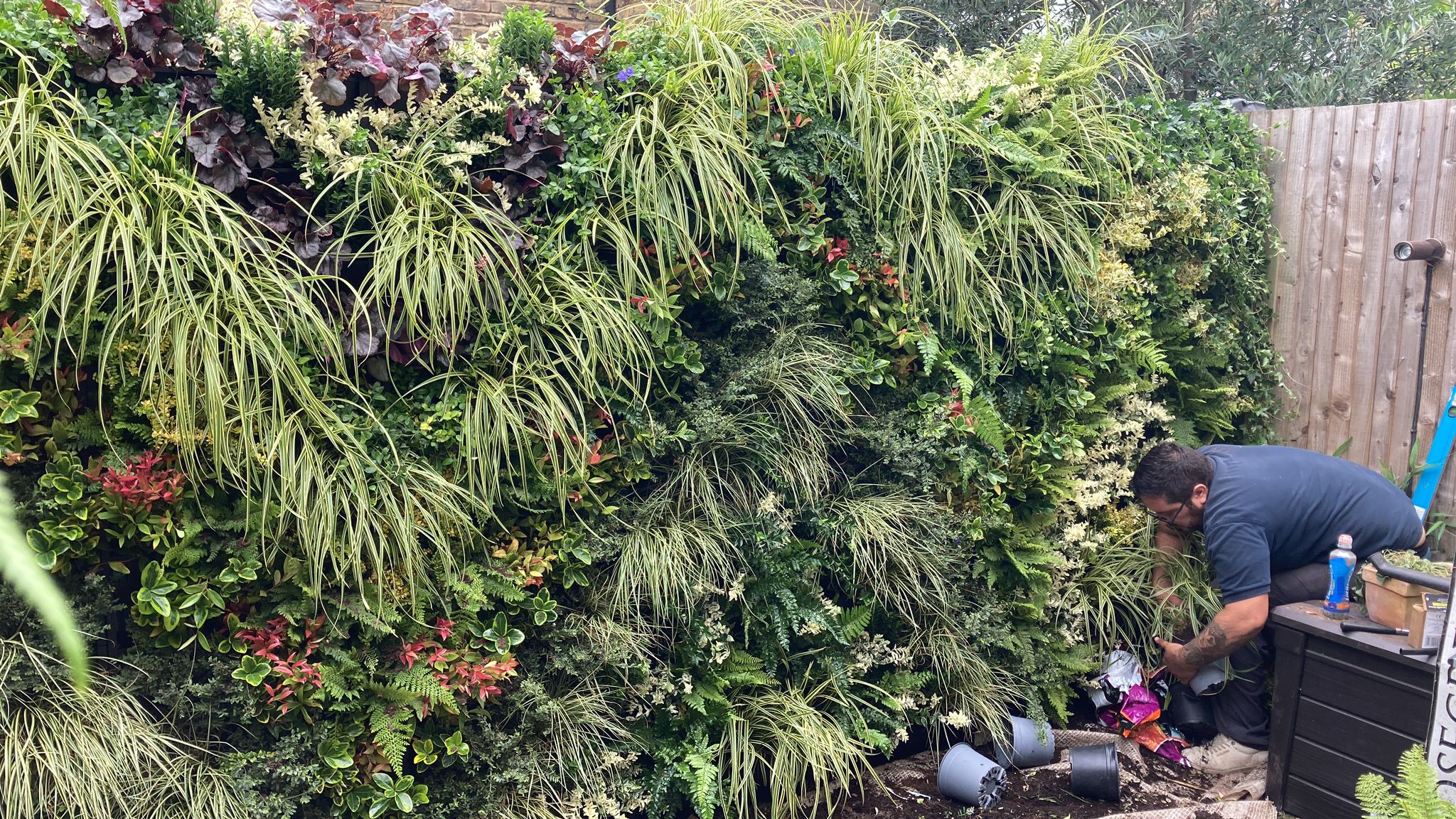
25 Sep Advantages of Living Walls over Moss Walls
When considering some kind of green wall for your home or business, you may have wondered about the different possibilities. Perhaps you want a living plant wall, also known as a vertical garden? Or what about a moss wall, made either of dried moss, or preserved moss? All of these look great in their own way, of course. But which is best? Are you aware of the benefits and disadvantages of each type? Let Rosewood help you see the advantages of living walls over moss walls – we prefer them for good reason!
So, what are the advantages and disadvantages of all these different green walls?
Let’s start with watering. Moss walls are either dried or preserved. Neither type needs watering as the moss isn’t growing. On the other hand, vertical gardens, full of living plants, need water to stay healthy. The need to water a living wall might seem a disadvantage compared to moss walls. However, most plant walls can be installed with fully automated irrigation making manual watering unnecessary. Living walls certainly need water, but you won’t need to think about it.
You might imagine that dried or preserved moss walls stay looking perfect without the need for maintenance, whereas a living wall will need trimming lightly, or a plant replacing now and again. We’re convinced that the living wall still wins, despite this! A dried moss wall has a crispy surface and loses its colour very quickly. This type of moss will not last very long before it needs replacing if you want it to look its best. Preserved moss, on the other hand, does last for many years. It retains its colour and texture and stays looking fresh and healthy without attention. But even a preserved moss wall can suffer surface damage, necessitating repairs to broken areas, so it is not totally maintenance-free. Also, the very thing that makes it easy to maintain is the thing we dislike about it. IT’S NO LONGER A LIVING THING!
A chemical process preserves the moss used to construct these pieces. Food colouring is used to create that ‘natural’ green! The moss sucks up a chemical solution including glycerin, which replaces the sap and stops the moss decaying. It can’t die, because it is no longer alive. We’ve read one moss wall provider stating proudly that “Having an indoor wall garden made of moss is almost like having an artificial one”, but we don’t think that’s something to shout about. In our opinion, many of the most important benefits of a plant wall are to do with the fact that it is living.
How do living plants benefit us?
A moss wall can certainly look amazing, like a piece of art. It might also create a ‘green vibe’ or a nod in the ‘hey, yeah, we love nature’ direction. However, it doesn’t give the building’s users the chance to commune with genuine living nature, and it’s that communion that allows people to take a deep and relaxing breath away from the stresses of the day. That sense of improved mental wellbeing is incredibly important, but it’s also matched by the physical benefits a living wall brings.
Preserved moss can’t clean the air like a living wall of real plants. Plants take in carbon dioxide and release oxygen as part of photosynthesis, and they even absorb pollutants such as formaldehyde that are common in modern interiors. The wall filters particulate matter from the air, reducing pollution. There have been many studies which prove that plants and the microbes found in soil media absorb harmful VOC’s and convert them into a compound which plants use for food.
With the oxygen boost it brings, and the reduction in pollutants, a living wall can improve air quality significantly. Cleaner air brings increases in focus and attention. Studies also show that in buildings where there are plenty of plants, people no longer suffer the same levels of headaches, respiratory infections, eye irritation, sore throats and tiredness as they do in buildings with fewer plants. In interiors with plenty of greenery, there is even a noticeable decrease in absence due to illness.
What about where a wall can be sited?
Another advantage of real vertical gardens is that they can be used outside as well as indoors. Moss walls are unsuitable for outdoor use as they need to stay dry. Living walls are amazing in almost any setting, interior or exterior, on balconies, in a courtyard or atrium, in a public space or a private one – it doesn’t matter where! It might also be useful to know that real plant walls reduce the ambient temperature of the air around them as they cool themselves in warm weather. This means that you can use less air-conditioning, saving energy and money in the long term.
How much do they cost?
A moss wall probably costs a little less than a plant wall, we won’t deny it. However, living walls can be energy saving, as mentioned in the previous paragraph, and if you factor in lower sickness rates and generally better mental and physical wellbeing, those extra costs seem worth it. A living wall may involve a slightly larger financial outlay than a moss wall, but the benefits are immense.
Conclusion
At Rosewood, we have debated whether to supply moss walls as well as living walls, and decided against it. We are so certain of the benefits of plants that we actively want to promote them. If you like the sound of better mental and physical health, a sustainable and truly green solution that adds visual interest too, then give Rosewood a call. We’ll be happy to discuss the possibilities for where you are.

